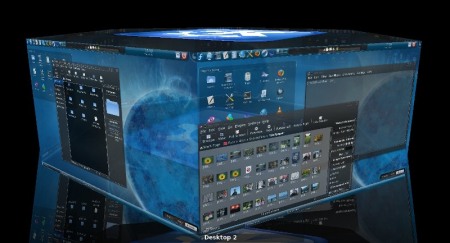
The vast majority of Windows users in the world have never experienced the advantages that a multiple desktop computer environment provides. That is because most people use Microsoft Windows and that operating system only comes with a single desktop environment*. Users of the Linux operating system have been enjoying multiple desktop capabilities for many years already, and they are about to experience the next step of the multiple desktop paradigm evolution. So why are multiple desktops useful and how much do they really help?
Single desktop deficiencies
First of all, lets discuss the problems that having only one desktop creates. Most people I know of like to place items on the desktop. They do that because they hope to be able to find them quickly next time they need them. The idea is to have them readily available rather than having to dig down searching for them. Ironically that is what they end up having to do, in a way. That is because just about every user likes to have two or more applications open at a time. And, more likely than not, those applications will be in the way when trying to reach for those “handy” desktop items.
Usability experts are well aware of that problem and that is why you hear them discouraging the use of desktop items. Microsoft has been trying for years to wean off its users from placing things on the desktop, but no matter how much they try, users continue to fall for the temptation of placing things on the desktop. Whose fault is it?
But, the difficulty of accessing items on the desktop is just part of the problem that comes with a single desktop interface. Since modern computers excel at multitasking most users enjoy being able to do more than one thing at a time. Unfortunately, the Windows interface does not scale well for multitasking. For example, lets say that one has just returned from a vacation and now finds some time to do some photo processing. This task will usually involve a file manager, and one or two image management applications. So far so good. We can manage to work with that in just one desktop. However, if you like taking pictures as much as I do, and if you are as much of a perfectionist as I am about the final quality of your photos, that task is likely to be a several hours long task.
Lets think about that for a moment. Can anyone really hold their undivided attention to a single task for several hours on a Saturday afternoon? Should any one even try to? In practice, I find it very hard to work on a single task for a long period of time. I get bored, uninterested, and unproductive. Switching between tasks allows me to keep my interest and intensity up. And I am quite sure that I am not alone in this. There have been many studies that find that one cannot efficiently maintain attention spans longer than 10 or 15 minutes. That is why it is recommend that teachers switch to a different teaching method every so often to keep the minds of their students engaged. I find the same applies to my type of work most of the time.
So getting back to our photo processing task, what other tasks are we likely to want to do in parallel with it? I don’t know about you, but I am rarely at the computer without running Firefox. I am also very likely to have a Word processor and an email client open, at least! That means that to switch between tasks in Microsoft Windows I am going to have to minimize and maximize applications often. And if I try to reach out for something on the desktop, restoring the sometimes multiple windows that belong to each task can start to get quite laborious. But why does it have to be that way? Having multiple desktops solves all of these problems.
Desktop shortcuts are a great way to start populating a desktop with the applications needed for the task it is going to be handling.
Multiple desktops advantages
I have to admit that, in spite of the fact that I had used Linux for many years, I was still mostly a one desktop user. What finally made me realize that I could work more efficiently by using multiple desktops was Compiz. With it, it was easy to see visually what was going on in each of the desktops and made me realize that I could separate my tasks between them. With KDE 4 one does not need to use Compiz to get the same 3D functionality. See this for example.
While those effects are fun and were instrumental in helping me understand the multiple desktop potential, I find that I don’t need 3D effects any more. I have developed a “standard” methodology for my work. I like to use between 4 and 6 desktops at a time, depending on if I am at work or at home. This allows me to have all the windows related to each task on their own desktop. Usually, the first desktop is reserved for Google Apps running on Firefox. Desktop 2 is file management. Desktop 3 is general web browsing. Desktop 4 is word processing, etc. These guidelines are not very rigid, but I tend to stick to them. It took me a while to unlearn the minimize and restore habits, but now I find that my workspace is much better organized and clean, and this makes it easier for me to work. There may be a bit of a learning curve, but it is not steep and it is very worth wile. Once you get used to the multiple desktops you will never want to go back.
Just last night, I was copying some very large files to an external hard drive on one desktop, backing up a DVD on another, browsing on another, and working on some spreadsheets and schedules on another. Of course, one can minimize and restore windows to do this too, but it is so much easier to switch desktops with a single click to see how the task is doing on another desktop (with multiple windows open), and then switch right back with another single click to the one that I am presently trying to give most of my attention. And, when I want to reach for an item on the desktop all I have to do is switch to a new desktop and click on it. No need to waste all that precious and handy space. Desktop shortcuts are a great way to start populating a desktop with the applications needed for the task it is going to be handling.
Desktop activities
And that takes us to what is clearly the next step in the evolution of the multiple desktop paradigm, the ability of being able to preconfigure multiple “activities”. The idea is that, instead of having a desktop populated with everything you could possibly need for any ‘activity’, one can have several types of desktops, each one populated with what one would need for a particular activity. For example, one could have a desktop populated for general work, one for graphics work, another for research, another for development, another for gaming, one with nothing but your beautiful desktop, etc. That way, if you are working on something and decide to start working on something else, all you have to do is start a new desktop and switch the activity. With two click of the mouse you are ready to go. Let me show you how it works.
Conclusion
So, are you convinced yet? If you are not, it is probably my fault. Do give working with multiple desktops a chance. Avoid the minimize button like the plague. Maybe then you will come to agree with me in thinking that single desktop interfaces are so last century it is not even funny.
*I am aware of several third party utilities that attempt to provide multiple desktop functionality to Windows. Unfortunately, neither of those utilities provides a smooth experience. They all fail due to various bugs and/or heavy resource utilization. What is needed is for Windows to provide native multiple desktops.

Leave a reply to CL17 Cancel reply